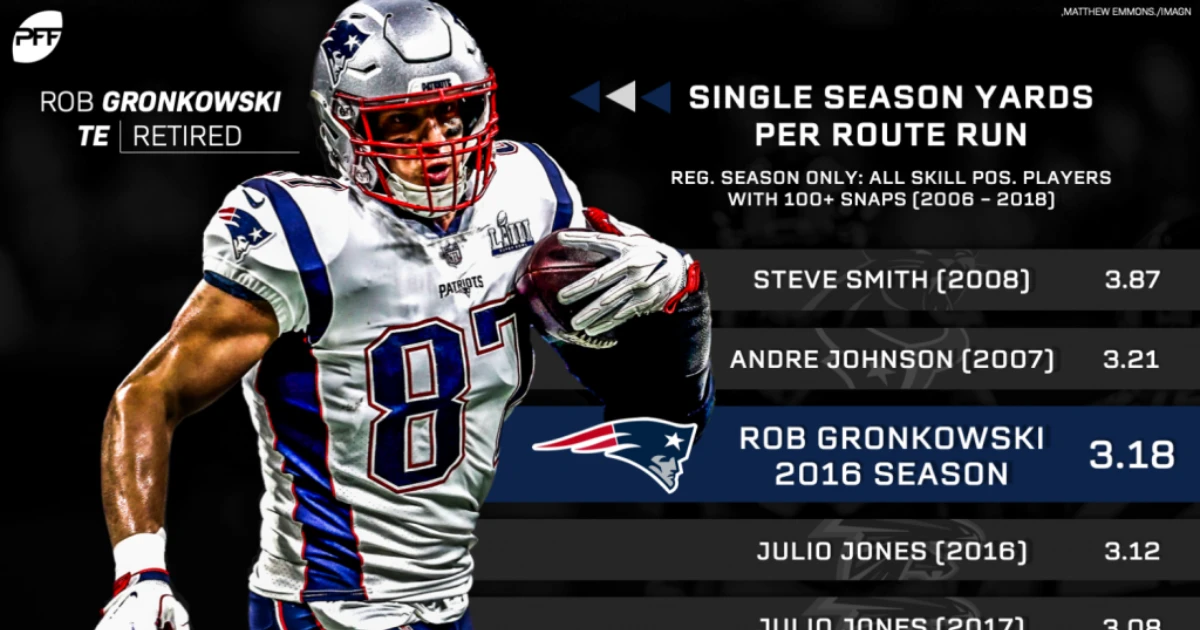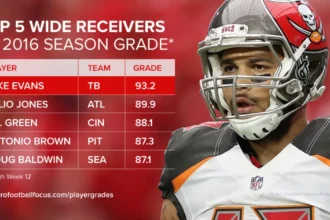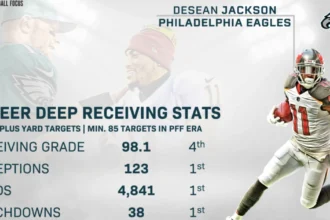Hey there, football fans! If you’re anything like me, you can’t help but smile when you think about Rob Gronkowski. The guy we all call “Gronk” wasn’t just a tight end—he was a force of nature on the field, a touchdown machine who partied as hard off it. From his early days catching passes from Tom Brady in New England to hoisting another Lombardi Trophy in Tampa Bay, Gronk’s career is the stuff of NFL dreams. In this article, we’re breaking down Rob Gronkowski Career Stats in a way that’s easy to follow, no matter if you’re a die-hard Pats fan or just dipping your toes into football history. We’ll keep it straightforward, sprinkle in some stories, and yes, include handy tables to make those numbers pop. Grab a snack, settle in, and let’s celebrate the man who redefined what a tight end could do.
Who Is Rob Gronkowski Career Stats? A Quick Intro to the Gronkster
Before we dive into the digits, let’s set the stage. Born on May 14, 1989, in Amherst, New York, Rob grew up in a family full of athletes—his brothers played in the NFL too! He starred at the University of Arizona, where he racked up some impressive college numbers before a back injury cut his junior year short. But that didn’t stop the New England Patriots from snagging him in the second round of the 2010 NFL Draft, 42nd overall. Little did they know they’d be getting a six-time Pro Bowler, four-time Super Bowl champ, and one of the most beloved personalities in sports.
Gronk’s style? Explosive. At 6’6″ and 265 pounds, he combined size, speed, and sure hands with a blocking prowess that made him a nightmare for defenses. His chemistry with Brady was legendary—think of it as peanut butter and jelly, but with more spikes and dances. Over 11 seasons (2010-2021), he suited up for the Patriots and Buccaneers, playing in 143 regular-season games. And those Rob Gronkowski Career Stats? They scream Hall of Fame. But we’re getting ahead of ourselves. Let’s start at the beginning.
College Days: Building the Foundation at Arizona
Gronk’s NFL stardom didn’t come out of nowhere. At Arizona Wildcats, he flashed the talent that would make him a star. Over two seasons (2007-2008), he played in 22 games, hauling in 75 receptions for 1,197 yards and 16 touchdowns. That’s an average of 16.0 yards per catch—pretty solid for a guy learning the ropes at tight end.
His freshman year was a breakout: 42 catches, 546 yards, and 10 TDs. As a sophomore, he added 33 receptions for 651 yards and 6 scores, earning first-team All-Pac-10 honors. Then came the herniated disc in his back, sidelining him for 2009. But scouts saw the upside, and the rest is history. Those college numbers weren’t just stats; they were a preview of the dominance to come. If you’re curious about his full college splits, check out the table below—it’s a quick snapshot.
| Year | Team | Games | Receptions | Yards | Yards/Catch | TDs |
|---|---|---|---|---|---|---|
| 2007 | Arizona | 13 | 42 | 546 | 13.0 | 10 |
| 2008 | Arizona | 9 | 33 | 651 | 19.7 | 6 |
| Career | Arizona | 22 | 75 | 1,197 | 16.0 | 16 |
Simple, right? Those 16 touchdowns in college hinted at the red-zone terror Gronk would become in the pros.
The Rookie Year: Hitting the Ground Running in 2010
Drafted by the Pats, Gronk wasted no time. In his debut season, he played all 16 games, catching 42 passes for 546 yards and a whopping 10 touchdowns. Sound familiar? It was almost identical to his freshman college year, but against NFL defenses! He became Brady’s go-to guy in the middle of the field, blocking like a lineman and celebrating like a wideout.
That year, the Patriots made it to Super Bowl XLV, where Gronk caught 4 passes for 109 yards—huge in a loss to the Packers. His rookie stats set the tone: efficient, explosive, and fun. He earned a Pro Bowl nod right out of the gate, proving he belonged. As we build toward his full Rob Gronkowski career stats, let’s remember— this was just the appetizer.
Peak Gronk: The Patriots Glory Years (2011-2018)
Oh man, if there’s a golden era for Gronk fans, it’s these years. From 2011 to 2018, he was unstoppable—when healthy, that is. Injuries like a broken ankle in 2012 and a herniated disc in 2013 tested him, but he bounced back fiercer each time. In 2011, he exploded for 90 receptions, 1,327 yards, and 17 TDs, earning First-Team All-Pro honors. That was his first of four straight Pro Bowls.
His 2014 season? A career-high 1,677 yards and 12 TDs on 82 catches. He broke records left and right, like the most TD receptions by a tight end in a season (tied at 10 early, then shattered). And don’t get me started on the playoffs—Gronk thrived under the lights, with multiple 100-yard games in Super Bowl runs.
But 2013 was tough: Just 7 games due to back issues, yet he still managed 4 TDs. In 2016, a hamstring tweak limited him, but he posted 1,076 yards and 8 scores. These years weren’t just about numbers; they were about clutch moments. Remember Super Bowl XLIX against Seattle? Gronk’s 11 catches for 112 yards helped seal the win. Or XLII in 2018, where his TD catch set up the comeback against the Rams.
Gronk’s Patriots tenure was defined by resilience. He missed time, sure, but when he played, he dominated. By 2018, he’d amassed 521 receptions for 7,861 yards and 79 TDs in the regular season alone. That’s Gronk magic—turning potential into production.
The Comeback King: Tampa Bay Buccaneers Era (2020-2021)
After retiring in 2019 (citing mental health and physical wear), Gronk couldn’t stay away. When Brady signed with the Bucs, he followed suit. Retirement lasted just 10 months! In 2020, he joined Tampa mid-season and immediately clicked. Playing 12 games, he caught 45 passes for 432 yards and 7 TDs, including a Super Bowl LV masterpiece: 6 catches, 67 yards, and 2 scores in a 31-9 rout of Kansas City.
2021 was his farewell tour. In 15 games, Gronk hauled in 55 receptions for 802 yards and 5 TDs. His yards-per-catch jumped to 14.6, showing he still had that deep-threat ability. Tampa made another deep playoff run, but Gronk bowed out after a divisional loss to the Rams. What a way to go—retired as a champion, with Brady by his side one last time.
The Bucs chapter added 100 receptions, 1,235 yards, and 12 TDs to his ledger, proving age (he was 32) was just a number. It also bumped his Super Bowl rings to four: XLIX, LI, LIII, and LV. Talk about a storybook ending!
Rob Gronkowski Career Stats: The Full Breakdown
Alright, stats lovers, this is what you came for. Let’s lay out Rob Gronkowski career stats in a clear table. We’re talking regular season here—playoffs get their own spotlight next. Over 11 seasons and 143 games, Gronk’s efficiency shines: 15.0 yards per reception on average. He was targeted 961 times, converting 64.6% into catches. Not bad for a guy who blocked as much as he caught!
I’ve pulled these from reliable NFL records (think Pro-Football-Reference and ESPN). Here’s the year-by-year:
| Year | Team | Games | Receptions | Targets | Yards | Yards/Rec | TDs | YAC | Longest |
|---|---|---|---|---|---|---|---|---|---|
| 2010 | NE | 16 | 42 | 59 | 546 | 13.0 | 10 | 200 | 35 |
| 2011 | NE | 16 | 90 | 124 | 1,327 | 14.7 | 17 | 411 | 49 |
| 2012 | NE | 11 | 55 | 70 | 821 | 14.9 | 11 | 285 | 41 |
| 2013 | NE | 7 | 39 | 48 | 497 | 12.7 | 4 | 178 | 33 |
| 2014 | NE | 15 | 82 | 111 | 1,124 | 13.7 | 12 | 328 | 46 |
| 2015 | NE | 15 | 72 | 96 | 1,120 | 15.6 | 11 | 373 | 69 |
| 2016 | NE | 8 | 25 | 32 | 374 | 15.0 | 3 | 128 | 53 |
| 2017 | NE | 16 | 69 | 89 | 1,084 | 15.7 | 8 | 360 | 78 |
| 2018 | NE | 14 | 47 | 67 | 543 | 11.6 | 3 | 133 | 28 |
| 2020 | TB | 12 | 45 | 60 | 432 | 9.6 | 7 | 99 | 29 |
| 2021 | TB | 15 | 55 | 76 | 802 | 14.6 | 5 | 246 | 49 |
| Career | Total | 143 | 621 | 961 | 9,286 | 15.0 | 92 | 2,741 | 78 |
See how his yards per catch rarely dipped below 13? That’s elite for a tight end. And those 92 TDs? Second all-time among TEs, behind only Tony Gonzalez’s receptions but ahead in scoring punch. YAC (yards after catch) shows his elusiveness—over 2,700 career, often turning short dumps into chunk plays.
Playoff Dominance: Where Gronk Shined Brightest
Regular season stats are great, but playoffs? That’s where legends are made. Gronk played 22 postseason games, catching 98 passes for 1,389 yards (14.2 avg.) and 15 TDs. He’s tied for second all-time in playoff receiving TDs for any position (behind Jerry Rice’s 22), and first among tight ends.
His Super Bowl performances are iconic: 297 yards and 4 TDs across four wins. In playoffs, he averaged nearly 63 yards per game—clutch as can be. Brady’s passer rating when targeting Gronk? A sky-high 124.0, better than with anyone else. That duo’s 79 regular + 15 playoff TDs? Second-most ever for a QB-WR/TE pair.
Quick playoff table for the highlight reel:
| Category | Games | Receptions | Yards | Yards/Rec | TDs |
|---|---|---|---|---|---|
| Playoffs | 22 | 98 | 1,389 | 14.2 | 15 |
| Super Bowls | 4 | 16 | 297 | 18.6 | 4 |
Numbers like these don’t lie—Gronk was built for January football.
Awards, Accolades, and the Man Behind the Stats
Stats tell the story, but awards add the shine. Gronk made five Pro Bowls (2011, 2014-15, 2017-18), earned four First-Team All-Pro nods, and snagged Comeback Player of the Year in 2014. Of course, those four Super Bowl rings are the crown jewels.
Off the field, he’s a philanthropist with the Gronk Nation Foundation, helping kids through sports. His personality—those shirtless dances, the “Gronk Spike”—made him a fan favorite. Post-retirement, he’s crushing it in media, wrestling (WWE champ!), and even NFL broadcasting. But his legacy? Forever tied to those Rob Gronkowski career stats that changed the tight end position.
Why Gronk’s Stats Still Matter Today
In an era of speedy slot receivers and versatile hybrids, Gronk’s numbers remind us of the classic TE blueprint: block, catch, score. He outproduced contemporaries like Travis Kelce in TDs per game (0.64 vs. 0.58) and held his own in yards despite fewer seasons. For young fans, he’s inspiration; for vets, nostalgia.









